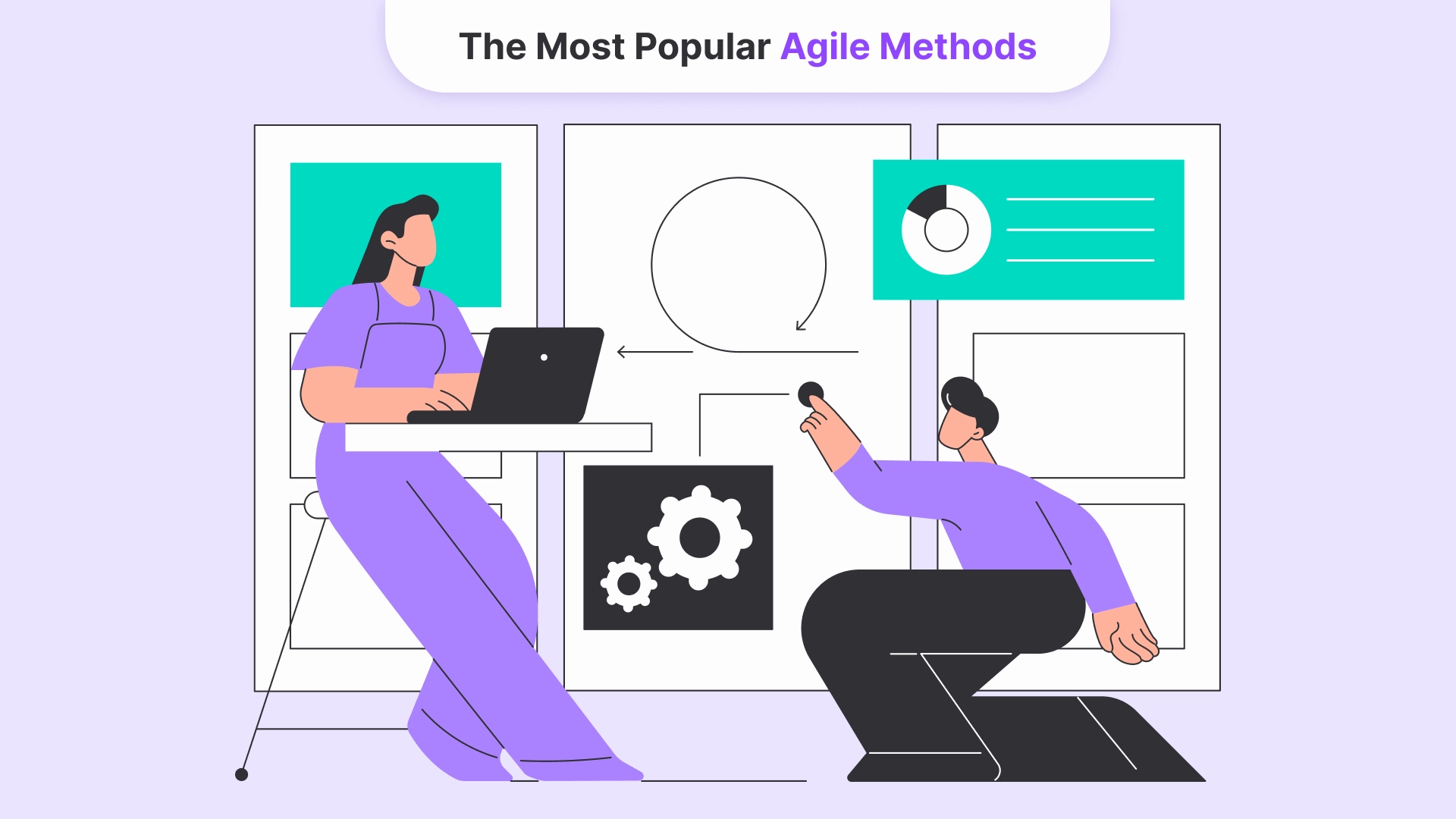

Methodologies in Software Engineering: The Evolution of Software Development Management
Technology is constantly changing, and so is software development. The way we create and use digital solutions has evolved dramatically, opening up new possibilities and challenges, changes and adaption.
In this article, we will look at some of the key software development cycles that have been shaping the whole industry from the very beginning till nowadays, and how they affect users. We will also discuss the advantages of adopting some trends, and how they can help you stay ahead of the competition. By following them, you can ensure that your software solutions are always up-to-date and relevant.
The Early Stages of Software Evolution
Waterfall Methodology (1950s-1960s)
Waterfall methods, or Linear development methods, follow a fixed and orderly process of software creation. In this way, the software project is split into separate stages, such as requirements analysis, design, implementation, testing, and deployment. Each stage has to be finished before going to the next one, and there is little or no feedback or change allowed between stages. Linear development methods work well for simple and clear projects that have stable and certain requirements and low risks. However, they are not very adaptable or flexible to changing customer needs or market situations, and they can be expensive and time-consuming if mistakes or changes are found late in the project.
Waterfall methods are still used in some industries (government, defense, etc.), where requirements are stable and changes are rare. For example, in healthcare and MedTech, some products require a high level of reliability and safety, such as an insulin pump that automatically injects insulin into the body of the patient. This complex invasive device with software needs rigorous testing and verification, so the product manager or owner can’t afford to change the requirements frequently. However, waterfall methods are not the best option for modern software development, where agility and adaptability are essential.
The Era of Iteration
The Spiral Model (1980s)
Later the Spiral model emerged as an alternative to the Waterfall. The Spiral model is a risk-driven software development process cycle. It allows for continuous feedback and changes throughout the project. Projects are divided into cycles, each consisting of four phases: planning, risk analysis, engineering, and evaluation. The Spiral model enhances adaptability and risk management, but it also has some drawbacks in handling larger projects.
Rapid Prototyping (late 1980s-early 1990s)
Rapid prototyping became popular in software engineering as a way to deal with the increasing complexity and uncertainty of software projects. It’s a method of making interactive and realistic models of a software product or feature and testing them with users to get feedback and improve the design. Rapid prototyping helps software engineers to check their ideas and assumptions and to avoid spending time and resources on building something that does not meet the user’s needs or expectations. It can also help software engineers to try out different options and alternatives, and to find new opportunities and innovations.
The Origins & Progress of Agile Approaches
The Agile Manifesto (2001)
The Agile methodology came up in the software development industry in the early 2000s. It represents a new way of making software that is more responsive, collaborative, and adaptive to the changing needs and expectations of customers and users.
Its beginning, the Agile Manifesto, is a document that was written by 17 software developers in 2001, who met to discuss their problems and challenges with the traditional for that times ways of software development. The Manifesto expressed the core values and principles of a new approach to software development, which they called Agile. It values people and interactions over processes and tools, working software over comprehensive documentation, customer collaboration over contract negotiation, and responding to change over following a plan. Agile also follows 12 principles that describe how to apply these values in practice.
Some of the most popular Agile methods are Scrum, Kanban, Extreme Programming (XP), Feature-Driven Development (FDD), and Lean Software Development. These methods share some common features, such as iterative and incremental development, frequent delivery and feedback, self-organizing and cross-functional teams, and continuous improvement.
The Agile Manifesto and Agile methodology changed the development world by introducing a new way of making software that is more customer-centric, quality-oriented, and innovation-driven. Agile software development allows for more creativity and flexibility, as the development team can explore different possibilities and alternatives, and adapt to the changing requirements and market conditions.
The Most Popular Agile Methods

There are many types of Agile methods, each with its characteristics, advantages, and disadvantages. Here are some of the most common ones:
Scrum
Scrum involves breaking down large projects into smaller, manageable increments called sprints, which typically last one to four weeks. Each sprint has a goal, a plan, and a review. Scrum also defines three roles: the product owner, the scrum master, and the development team. It is suitable for complex and dynamic projects that require frequent feedback and adaptation. However, it can also be challenging to implement, especially for large or distributed teams, and it requires a high level of commitment and discipline from all stakeholders.
Kanban
Kanban is a visual and flexible method that focuses on optimizing workflow. It uses a board with columns that represent different stages of the process, such as to-do, in progress, and done. Each work item is represented by a card that moves across the board as it progresses. Kanban limits the number of cards in each column to avoid bottlenecks and waste. It’s proper for projects that have continuous and unpredictable workloads, and that need to deliver value quickly and frequently. However, it can also be difficult to measure progress and quality, and it may not provide enough structure or guidance for some teams.
Extreme Programming (XP)
XP is a method that emphasizes high-quality software development through frequent testing, feedback, and communication. It advocates for practices such as pair programming, test-driven development, continuous integration, and refactoring. XP is cool for projects that have changing or unclear requirements, and that need to deliver reliable and maintainable software. However, it can also be demanding and stressful for developers, and it may not be compatible with some organizational cultures or customer expectations.
Feature-Driven Development (FDD)
FDD focuses on delivering features that provide value to the customer. It consists of five phases: develop an overall model, build a feature list, plan by feature, design by feature, and build by feature. FDD is the right choice when you have well-defined and stable requirements for the project. However, it can also be rigid and inflexible, and it may not support frequent changes or feedback.
Lean
Lean aims to eliminate waste and maximize value. It is based on the principles of lean manufacturing, such as eliminating defects, reducing inventory, and improving efficiency. Lean is suitable for projects that have limited resources, and that need to deliver high-quality products with minimal overhead. However, it can also be challenging to apply, especially for complex or innovative projects, and it may require a significant cultural shift for some organizations.
Dynamic Systems Development Method (DSDM)
DSDM is a method that combines the best practices of Agile and traditional methods. It follows a project lifecycle that consists of four stages: feasibility, foundations, evolutionary development, and deployment. DSDM is used for projects that have fixed time, cost, and quality constraints, and that need to deliver business benefits. However, it can also be complex and expensive, and it may not be flexible enough for some projects.
Crystal
Crystal is a family of methods that are tailored to the specific characteristics of each project, such as size, criticality, and priority. Crystal methods are based on seven properties: frequent delivery, reflective improvement, osmotic communication, personal safety, focus, easy access to expert users, and technical environment. Crystal is well for projects that have diverse and changing needs, and that need to deliver customer satisfaction. However, it can also be vague and inconsistent, and it may not provide enough guidance or standards for some teams.
In Conclusion
Software development methodologies have undergone a remarkable change, moving from the strict frameworks of Waterfall to the agile approaches of Agile (it’s not a tautology, it’s the truth). The Agile Manifesto, published in 2001, signaled a new way of thinking, emphasizing teamwork, flexibility, and customer delight.
As software engineering keeps progressing, the key is finding a balance between structure and flexibility. Adopting a mindset that values teamwork, embraces change, and chooses the appropriate method ensures success in software development management.
Faq
What is the waterfall model and how does it differ from agile development?
+The waterfall model is a linear, sequential way of developing software, where each phase has to be completed before the next one can start, and there is little or no feedback or change allowed between phases. Agile development is a more iterative and flexible way, where the software project is divided into smaller and manageable parts, called iterations or increments, which can be evaluated and improved based on feedback from customers and stakeholders. The main difference is that the waterfall model is suitable for simple and well-defined projects, while agile development is more adaptable and ideal for complex and dynamic ones.
What are the key principles of agile development methodologies?
+Agile development methodologies are based on the Agile Manifesto, which defines the values and philosophy of agile software development. The Agile Manifesto has 12 principles that describe how to deliver software products that satisfy the customer, welcome changing requirements, deliver working software frequently, collaborate with the customer, respond to change, and improve continuously.
How does iterative and incremental development contribute to software evolution?
+Iterative and incremental development helps software evolution by letting digital solution makers learn from the development and use of the software, and to add feedback and changes to it. This way, the software can be more flexible, scalable, and agile, and can meet the changing needs and expectations of customers and users. Iterative and incremental development also lets software developers try out different options and alternatives, and find new opportunities and innovations.
Tell us about your project
Fill out the form or contact us

Tell us about your project
Thank you
Your submission is received and we will contact you soon
Follow us
